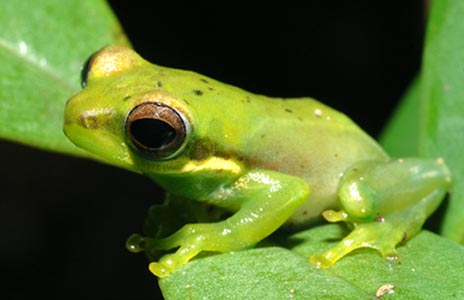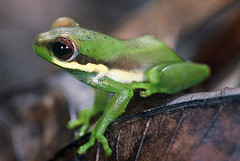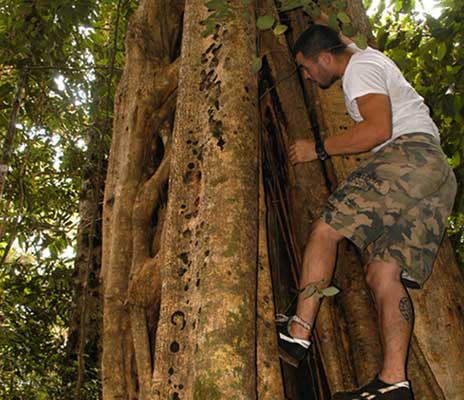Four New Frogs Discovered In Cambodia
Posted by: Loren Coleman on December 19th, 2008
Fauna & Flora International (FFI) has announced the discovery of a previously unknown species of frog in Cambodia. The amphibian is unusual in that is has green blood and turquoise-colored bones, a result of its transparent skin and a pigment that may make the species unpalatable to predators. It was discovered by L. Lee Grismer.
The Samkos bush frog (Chiromantis samkosensis) was discovered along with three other undescribed species of frog — the Cardamom bush frog (Philautus cardamonus), Smith’s frog (Rana faber), and the Aural horned frog (Megophrys auralensis) — during surveys of the Cardamom Mountains, a remote range in Cambodia. The research turned up more than 40 amphibian species not previously known to occur in Cambodia.
The green-blooded turquoise-boned Samkos bush frog (Chiromantis samkosensis) is one of four new frog species discovered by Fauna & Flora International in Cambodia.
Cambodian natives, Thou Chav (left) and Thy Neang (right) with L. Lee Grismer, La Sierra University professor of biology, during one of his summer research excursions.
Jesse Grismer (L. Lee Grismer’s son) looks for amphibians and reptiles while dangling from a tree in the Aural Mountains of Cambodia while on a research expedition for new species of amphibians and reptiles.
FFI says the Samkos bush frog stands out among the new discoveries for its “strange” bone and blood color, thought to be the result of biliverdin, a metabolic waste product usually processed in the liver.
“In this species, the biliverdin is passed back into the blood giving it a green colour; a phenomenon also seen in some lizards,” explained FFI in a news release. “The green biliverdin is visible through the frog’s thin, translucent skin, making it even better camouflaged and possibly even causing it to taste unpalatable to predators.”
FFI says the species is apparently very rare, living in a niche habitat of evergreen forest at an elevation of around 500 meters. Little is known about its ecology other than it appears to breed in temporary rain pools.
Strangely, from what I understand, Chiromantis samkosensis is a moss frog, found in Cambodia in the Cardamom Mountains, and first described in 2007, not 2008.
Source for original announcement: Lee Grismer, L. (2007). “A New Species of Chiromantis Peters 1854 (Anura: Rhacophoridae) from Phnom Samkos in the Northwestern Cardamom Mountains, Cambodia”. Herpetologica 63: 392.
Fauna & Flora International announced the discovery of the four previously unknown species of frogs in conjunction with the publication of a new field guide of frogs of Cambodia.
About Loren Coleman
Loren Coleman is one of the world’s leading cryptozoologists, some say “the” leading living cryptozoologist. Certainly, he is acknowledged as the current living American researcher and writer who has most popularized cryptozoology in the late 20th and early 21st centuries.
Starting his fieldwork and investigations in 1960, after traveling and trekking extensively in pursuit of cryptozoological mysteries, Coleman began writing to share his experiences in 1969. An honorary member of Ivan T. Sanderson’s Society for the Investigation of the Unexplained in the 1970s, Coleman has been bestowed with similar honorary memberships of the North Idaho College Cryptozoology Club in 1983, and in subsequent years, that of the British Columbia Scientific Cryptozoology Club, CryptoSafari International, and other international organizations. He was also a Life Member and Benefactor of the International Society of Cryptozoology (now-defunct).
Loren Coleman’s daily blog, as a member of the Cryptomundo Team, served as an ongoing avenue of communication for the ever-growing body of cryptozoo news from 2005 through 2013. He returned as an infrequent contributor beginning Halloween week of 2015.
Coleman is the founder in 2003, and current director of the International Cryptozoology Museum in Portland, Maine.














If that first one isn’t a juvenile, then it must surely get the record for largest eye-to-body-length-ratio!
thats awsome,
kinda reminds of the movie ‘Aliens’, where their blood was green acid
the constant stream of new species just helps to confirm the existence of cryptids: if those other, recently-discovered animals have been around for so long without us even noticing them, then why cant other creatures also exist, creatures that we have seen but not confirmed?
hmm?